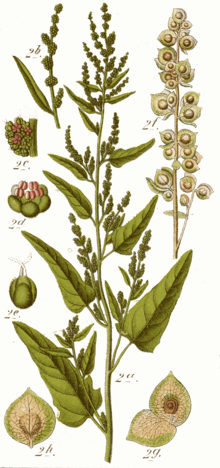Orache
| Atriplex | |
|---|---|
 |
|
|
Garden Orache (Atriplex hortensis) From Sturm & Sturm (1796): Deutschlands Flora in Abbildungen. |
|
| Scientific classification | |
| Kingdom: | Plantae |
| (unranked): | Angiosperms |
| (unranked): | Eudicots |
| (unranked): | Core eudicots |
| Order: | Caryophyllales |
| Family: | Amaranthaceae |
| Subfamily: | Chenopodioideae |
| Tribe: | Atripliceae |
| Genus: |
Atriplex L. |
| Species | |
|
About 250-300, see text |
|
| Synonyms | |
|
Blackiella Aellen |
|
About 250-300, see text
Blackiella Aellen
Cremnophyton
Haloxanthium Ulbr.
Morrisiella Aellen
Neopreissia Ulbr.
Obione Gaertn.
Pachypharynx Aellen
Senniella Aellen
Theleophyton (Hook.f.) Moq.
Atriplex (/ˈætrᵻplɛks/) is a plant genus of 250–300 species, known by the common names of saltbush and orache (or orach). It belongs to the subfamily Chenopodioideae of the family Amaranthaceae (which include the Chenopodiaceae of the Cronquist system). The genus is quite variable and widely distributed. It includes many desert and seashore plants and halophytes, as well as plants of moist environments. The generic name originated in Latin and was applied by Pliny the Elder to the edible oraches. The name saltbush derives from the fact that the plants retain salt in their leaves; they are able to grow in areas affected by soil salination.
The species in genus Atriplex are annual or perennial herbs, subshrubs, or shrubs. The plants are often covered with bladderlike hairs, that later collapse and form a silvery, scurfy or mealy surface, rarely with elongate trichomes. The alternate or rarely opposite leaves are petiolate or sessile, often persistent or tardily deciduous. The flat or slightly fleshy leaf blades are either entire, or serrate, or lobed and very variable in shape.
...
Wikipedia
